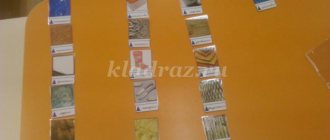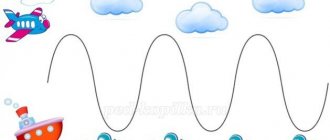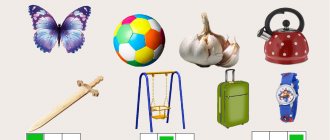Summary of a speech therapy lesson on the topic. Sound differentiation [V-F]
Topic: Differentiation of sounds [V-F]
Target:
learn to differentiate sounds [V-F], determine their position in syllables and words;
Tasks:
- learn to differentiate sounds [V-F] by sonority - deafness, relying on articulatory, visual and motor sensations;
- develop skills of sound-letter analysis and phonemic perception, self-control skills;
- develop spelling vigilance;
- expand your vocabulary through word formation;
- cultivate interest in classes, form positive learning motivation;
Equipment:
demonstration pictures, envelope with cards, graphic sound profiles [V – F].
Progress of the lesson
I. Organizational moment
- Hello children. Sit down.
- Today everyone is in a good mood, so look at each other, smile sweetly and get ready for class. To begin, listen to the task and prepare to answer.
— Determine the number of sounds in your last name.
II. Main part
Introduction to the topic
— And now I propose a task separately for boys and girls. Boys do the first line, and girls do the second.
- Make up words using the first sounds of word-pictures.
(pictures on the board: cornflower, bus, knife, apple, apron, stork, berry)
- Who's ready? Let's listen.
- Absolutely right. Vanya, Faya.
-What do these words mean? (Names) (Portraits of Vanya and Faya are hung)
- Name the first sounds in their names. (Sounds V-F)
- Who has guessed and is ready to voice the topic of our lesson?
— Write down today’s date and topic of the lesson.
- And also write down the names of the heroes of today’s lesson: VANYA, FAYA.
- Underline the letters: B - with two strokes, F - with one.
1. Characteristics of sounds according to articulatory and acoustic characteristics, based on graphic profiles of sounds (on the board, accompanied by a pointer)
— When pronouncing sounds [V-F], the lower lip is slightly retracted and pressed against the upper teeth, the upper lip is slightly raised. The upper teeth are visible. The tip of the tongue extends slightly from the lower teeth, the tongue is flat. The exhaled air breaks into the gap between the upper teeth and lower lip. The sound [B] is pronounced with a voice, which means that the vocal cords are working. Sound [F] – no voice, vocal cords resting.
— Place the back of your hand to your throat and pronounce the sound [B] for a long time. Do you feel your vocal cords shaking?
- Now say the sound [F]. What do you feel? (vocal cords do not tremble, rest)
- Conclude which of the sounds is voiced and which is unvoiced. Why?
- So, the sound [B] is a consonant, voiced; sound [F] – consonant, unvoiced.
- Now, let's think and say where we hear these sounds in the world around us. (We hear the sound [B] when the engine (of a car, plane, helicopter, motorcycle) hums. This is how little children play with cars)).
(We hear the sound [F] when the doors of a bus close or open, a Kamaz vehicle stops; this is how we blow out a candle, a match; this is how a hedgehog snorts)
2. Speech warm-up
- Repeat after me in a chain of pure sayings:
Va-va-va - there is grass in the yard Fa-fa-fa - the bride has a veil Wo-wo-wo - the waves are raging Fo-fo-fo - the lanterns are burning You-you-you - the eyes of the owl Fo-fy-fy - snorting hedgehogs
3. Game “Clap and Stomp”
— Let’s play the game “Clap and Stomp” and find out who is very attentive. I will name words with sounds [V – F]. For words with the sound V - stomp, with the sound F - clap.
(cow, elevator, eagle owl, owl, bed, cotton wool, wardrobe, cap, caftan, crow)
4. Finding pictures with sounds [V – F], determining the place of the sound in a word (at the beginning, middle, end)
- Here are picture words in which the sounds [V-F] are pronounced. I propose to distribute the pictures between Vanya and Faya. Two people will work at the board, and the rest will check the correctness of the task.
(After the children distribute the pictures, you should clarify the place of the sound in the word: at the beginning, middle, end.)
- We name the object and the place of the sound in the word: at the beginning, middle, end.
5. Exercise “An extra word.”
- In the next task, copy down the words, insert the missing letters V-F, underline V with two strokes, F with one. Find the “extra” word, mark it with a cross and explain why?
Koro.a, s.ekla, .utbol, kla.ishi.
That. Li, .Ontan, Ke.ir, .Alenki.
.erba, ko.rik, shar.ik, slo.a.
6. Graphic representation of the word.
— Let’s practice isolating syllables with the letters V-F in words. Let's depict this graphically. We continue to work in notebooks.
Sample: wok ___,
station, nightingale, violets, coffee, gate, carriage, broom, lantern.
— I remind you of the sequence of work. You read the word, count the number of syllables based on the number of vowels, draw the number of syllables, determine the place of the letter in the word, write down the syllable.
7. Solving a crossword puzzle.
- The time has come for ingenuity. If you solve the riddles, you will solve the crossword puzzle.
| IN |
| IN |
| IN |
| IN |
| F |
| F |
| F |
| F |
- They go for water - they sing sonorous songs. And they go back - Tears are shed. (Buckets)
- The streams rang, the rooks flew in. The bee brought the first honey to her house, the hive. Who can say, who knows, When this happens? (Spring)
- It prowls the field, sings and whistles, breaks trees, bends it to the ground. (Wind)
- Without legs and without wings, it flies quickly, you won’t catch it. (Time)
- A sign indicating a number. (Number)
- Shoes. (Shoes)
- Mineral resource. What is gasoline, kerosene, and fuel oil obtained from? (Oil)
- Car driver. (Chauffeur)
8. Physical exercise “Breeze”
The wind is blowing in our faces. The tree swayed. The tree is getting higher and higher, The breeze is getting quieter and quieter...
9. Composing words from individual syllables. (Pictures on the board: crow, pheasant)
— Did you recognize the birds? Name them.
— Pay attention to how the word is spelled: CROW
— A crow flew in and brought an envelope. The envelope is not simple, but with a task. Each of you will receive a card and make up a word from syllables. We will work in a chain at the board, the rest in our notebooks.
The envelope contains cards with syllables for each child:
ron, in nush, in, ka, ro nyo, ro, nok, in niy, ro, in e, ron, in
Writing words on the board:
Raven, crow, crow, little crow, crows, crow, crow.
- Circle the letter O in the words with a red pencil, put emphasis in all words, based on the vowels, divide the words into syllables, highlight the same root in the words.
- What is the name of such a group of words? (Single roots)
— Underline the letter B with two strokes.
— Orally we form related words with the word PHEASANT. (listen)
- And now I dictate, and you write down:
pheasant, baby pheasant, pheasants, pheasant (eye), pheasant (nest).
- What are these words called? (cognate)
- Highlight the common root, F - underline it with one line.
- Name the first sounds in the words CROW AND PHEASANT. Describe these sounds. (In the word RONA, V – consonant, voiced; in the word FEATHER, F – consonant, voiceless.)
10. Work on a proverb. (A proposal is written on the board)
The crow missed the crows.
- Read the sentence.
- This is a proverb. Let's try to explain the meaning of the proverb. (Listen to the children)
- Let's practice remembering this proverb. First, we will say it in chorus 2 times, and then each one independently - in a low voice.
- Once again - with your eyes closed.
- Pay attention to all the words in the sentence, they have the same root. And now I close the recording, and you write down this sentence from memory.
- In all words, highlight the common root. Underline the letter B with two strokes.
— Let’s practice pronouncing this sentence quickly.
— Come up with a sentence with the word PHEASANT. Let's listen.
- Whose proposal did you like? Let's write it down. Underline the letter F- with one line.
III. Lesson summary
.
- What sounds did we learn to distinguish today? - Describe these sounds. - Thank you everyone for the lesson.




